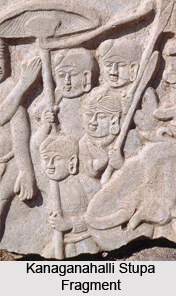 Kanaganahalli is a significant Buddhist site, famous for an old Buddhist Mahastupa which is located in Chitrapur Taluk, Gulbarga District in the southern Indian state of Karnataka, on the left banks of Bhima River. It is based at a distance of nearly 3 kms away from Sannati. The closest railway station of Kanaganahalli is Nalwar, which is based about 19 kms away from Kanaganahalli. The Archaeological Survey of India has excavated the region which is 2.5 kms from the Chandrala Parameshwari Temple of Sannati.
Kanaganahalli is a significant Buddhist site, famous for an old Buddhist Mahastupa which is located in Chitrapur Taluk, Gulbarga District in the southern Indian state of Karnataka, on the left banks of Bhima River. It is based at a distance of nearly 3 kms away from Sannati. The closest railway station of Kanaganahalli is Nalwar, which is based about 19 kms away from Kanaganahalli. The Archaeological Survey of India has excavated the region which is 2.5 kms from the Chandrala Parameshwari Temple of Sannati.
History of Kanaganahalli
The ruins of Kanaganahalli are as old as the 1st century BC till the 3rd century AD. According to the `Hama Chaitya` inscriptions, the stupa at Kanaganahalli was erected during the 1st century BC and was existent during the Mahayana and Hinayana people during the 3rd and 4th centuries AD. The architectural and sculptural art-forms of Kanaganahalli were influenced by the Amaravati School of Art, particularly during the pre-Christian ages. The stupa situated here is said to be the most attractive in the history of stupa architecture in southern India. However, the art-forms of Kanaganahalli are an enhanced version of the paintings of Amaravati School of Art, complete with geometrical motifs, decoration of contemporary ages and floral patterns. The portraits of Satavahana rulers and emperor Ashoka are present on the Kanagahalli Maha Stupa.
Archaeological Excavations at Kanaganahalli
The excavations conducted during the years 1994 to 1998 have led to the discovery of several structures of bricks, especially votive stupas and `Chaityagriha`. Various forms of stupas like pillars, capitals, sculptured slabs, railings, `Yaksha` sculptures and idols of Lord Buddha have also been unearthed. Sculptured panels found in Kanaganahalli consist of `Jataka` tales and the life of Buddha. The sculptures of King Ashoka is said to be amongst the most notable discoveries and the other excavations have revealed above 50 inscriptions. The ruins of brick-made structures have been found, thanks to the excavations which had been conducted from the year 2000 to 2002. Towards the north-western side of the stupa exists a monastic complex. Lead coins engraved with the names of Pulumavi, Satakarni, Yajnasri, who were Satavahana rulers. A beautiful portrait of Ashoka, accompanied by his queens and female attendants has also been found at this area.



















